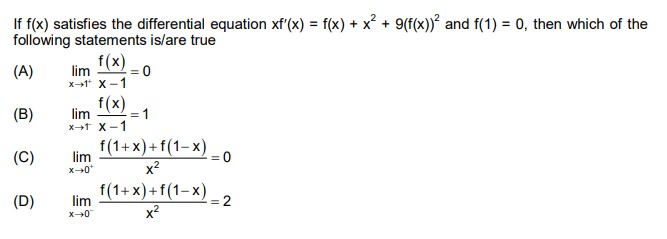Question
Question: If f(x) satisfies the differential equation xf'(x) = f(x) + x² + 9(f(x))² and f(1) = 0, then which o...
If f(x) satisfies the differential equation xf'(x) = f(x) + x² + 9(f(x))² and f(1) = 0, then which of the following statements is/are true

limx→1+x−1f(x)=0
limx→1+x−1f(x)=1
limx→0+x2f(1+x)+f(1−x)=0
limx→0−x2f(1+x)+f(1−x)=2
B, D
Solution
The given differential equation is xf′(x)=f(x)+x2+9(f(x))2. We are given the initial condition f(1)=0.
Step 1: Transform the differential equation.
Rearrange the equation to isolate terms involving f(x) and f′(x): xf′(x)−f(x)=x2+9(f(x))2
Divide both sides by x2: x2xf′(x)−f(x)=1+9(xf(x))2
Recognize that the left side is the derivative of xf(x): dxd(xf(x))=1+9(xf(x))2
Step 2: Solve the differential equation.
Let y=xf(x). The equation becomes a separable differential equation: dxdy=1+9y2 1+9y2dy=dx
Integrate both sides: ∫1+(3y)2dy=∫dx
To integrate the left side, let u=3y, so du=3dy⟹dy=3du. ∫1+u213du=∫dx 31arctan(u)=x+C
Substitute back u=3y: 31arctan(3y)=x+C
Step 3: Apply the initial condition to find C.
Given f(1)=0. Since y=xf(x), at x=1, y(1)=1f(1)=10=0. Substitute x=1 and y=0 into the general solution: 31arctan(3⋅0)=1+C 31arctan(0)=1+C 0=1+C⟹C=−1
Step 4: Write the particular solution for f(x).
Substitute C=−1 back into the solution: 31arctan(3y)=x−1 arctan(3y)=3(x−1) 3y=tan(3(x−1)) y=31tan(3(x−1))
Substitute back y=xf(x): f(x)=3xtan(3(x−1))
Step 5: Evaluate the given limits.
(A) and (B): limx→1+x−1f(x) Substitute the expression for f(x): limx→1+x−13xtan(3(x−1)) =limx→1+3x⋅x−1tan(3(x−1))
Let h=x−1. As x→1+, h→0+. =limh→0+31+h⋅htan(3h)
Using the standard limit limt→0ttan(kt)=k: =31+0⋅3=31⋅3=1 So, limx→1+x−1f(x)=1. Statement (A) is false. Statement (B) is true.
(C) and (D): limx→0+x2f(1+x)+f(1−x) and limx→0−x2f(1+x)+f(1−x) Let L=limx→0x2f(1+x)+f(1−x). As x→0, f(1+x)+f(1−x)→f(1)+f(1)=0+0=0. The limit is of the form 00. Apply L'Hopital's Rule: L=limx→0dxd(x2)dxd(f(1+x)+f(1−x)) L=limx→02xf′(1+x)⋅1+f′(1−x)⋅(−1) L=limx→02xf′(1+x)−f′(1−x)
Again, as x→0, f′(1+x)−f′(1−x)→f′(1)−f′(1). We need to find f′(1). From the limit in (B), limx→1+x−1f(x)−f(1)=f′(1) (since f(1)=0). So f′(1)=1. Thus, the limit is again of the form 00. Apply L'Hopital's Rule again: L=limx→0dxd(2x)dxd(f′(1+x)−f′(1−x)) L=limx→02f′′(1+x)⋅1−f′′(1−x)⋅(−1) L=limx→02f′′(1+x)+f′′(1−x)
Since f′′(x) is continuous around x=1, we can substitute x=0: L=2f′′(1)+f′′(1)=f′′(1)
Now we need to calculate f′′(1). First, find f′(x): f(x)=3xtan(3(x−1)) Using the product rule and chain rule: f′(x)=31tan(3(x−1))+3x⋅sec2(3(x−1))⋅3 f′(x)=31tan(3(x−1))+xsec2(3(x−1))
Now find f′′(x): f′′(x)=31sec2(3(x−1))⋅3+[1⋅sec2(3(x−1))+x⋅2sec(3(x−1))⋅(sec(3(x−1))tan(3(x−1))⋅3)] f′′(x)=sec2(3(x−1))+sec2(3(x−1))+6xsec2(3(x−1))tan(3(x−1)) f′′(x)=2sec2(3(x−1))+6xsec2(3(x−1))tan(3(x−1))
Evaluate f′′(1): f′′(1)=2sec2(3(1−1))+6(1)sec2(3(1−1))tan(3(1−1)) f′′(1)=2sec2(0)+6sec2(0)tan(0) Since sec(0)=1 and tan(0)=0: f′′(1)=2(1)2+6(1)2(0)=2+0=2
So, L=f′′(1)=2. This means limx→0+x2f(1+x)+f(1−x)=2 and limx→0−x2f(1+x)+f(1−x)=2. Statement (C) is false. Statement (D) is true.
The true statements are (B) and (D).
